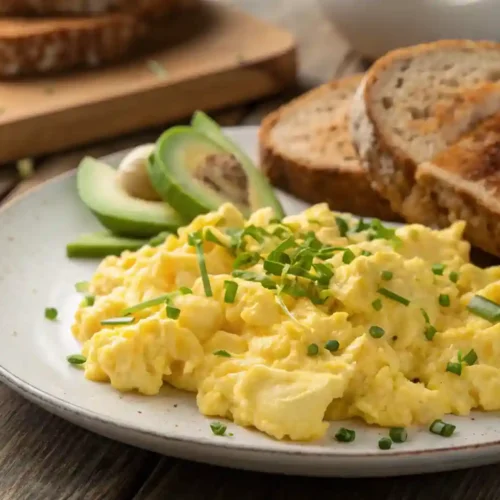
Scrambled Eggs Nutrition Facts The Truth Will Surprise You
Unlock the scrambled eggs nutrition facts you need to know. Packed with protein, healthy fats, and essential nutrients, they’re the ultimate superfood!
Ingredients
Eggs (2-4 large, organic or pasture-raised preferred)
- – A powerhouse of protein healthy fats, and essential vitamins. Fresh eggs yield the best texture and taste.
Butter (1 tablespoon, unsalted, grass-fed if available)
- – Adds richness enhances flavor, and prevents sticking while cooking.
Milk or cream (1-2 tablespoons, optional)
- – Helps achieve a softer fluffier consistency. Whole milk or heavy cream works best.
Salt (to taste, preferably sea salt or Himalayan salt)
- – Enhances the natural flavors of the eggs.
Black pepper (to taste, freshly ground preferred)
- – Adds a subtle kick and depth to the dish.
Optional Additions for Extra Flavor and Nutrition
Cheese (cheddar, feta, parmesan, or goat cheese, finely grated or crumbled)
- – Increases protein content and adds a creamy savory touch.
Herbs (chives, parsley, basil, or thyme, finely chopped)
- – Fresh herbs elevate the flavor profile while adding antioxidants.
Vegetables (spinach, mushrooms, tomatoes, or bell peppers, diced and pre-cooked if necessary)
- – Boosts vitamins fiber, and overall nutritional value.
Protein Boosters (smoked salmon, turkey, or crispy bacon, chopped)
- – A great way to increase protein intake while enhancing taste.
Spices (paprika, cayenne pepper, or garlic powder)
- – Adds warmth and depth to the flavor without overpowering the eggs.
Instructions
Step 1: Prepare the Ingredients
- Before starting, gather all the ingredients. Crack the eggs into a bowl, add a pinch of salt and pepper, and whisk until fully combined. If using milk or cream, mix it in at this stage for extra creaminess.
Step 2: Heat the Pan and Melt the Butter
- Use a non-stick or cast-iron skillet for even cooking. Set the heat to low or medium-low and add butter, allowing it to melt gently without browning. A low temperature is crucial for preventing overcooked, rubbery eggs.
Step 3: Cook the Eggs Slowly
- Pour the beaten eggs into the pan.
- Let them sit undisturbed for about 10-15 seconds until the edges start to set.
- Using a rubber spatula, gently stir the eggs in slow, circular motions, pushing the cooked parts toward the center.
- Continue stirring and folding the eggs as they cook, ensuring they stay soft and creamy.
Step 4: Remove from Heat at the Right Time
- As soon as the eggs are just slightly undercooked, remove the pan from heat. The residual warmth will continue to cook them. Overcooking leads to dry, rubbery eggs, so timing is key.
Step 5: Add Finishing Touches
- For an extra burst of flavor and nutrition, stir in grated cheese, fresh herbs, or sautéed vegetables. If you're exploring egg alternatives, you might enjoy this Vegan Cheese Omelette, which offers a delicious, plant-based twist with high-protein ingredients.
Step 6: Serve Immediately
- Transfer the scrambled eggs to a warm plate and enjoy them while they’re soft and silky. Pair with whole-grain toast, avocado slices, or smoked salmon for a complete, nutrient-rich meal.
Notes
Nutrition Information (Per Serving)
- Calories: 200
- Protein: 14g
- Fat: 15g
- Carbohydrates: 2g
- Saturated Fat: 6g
- Cholesterol: 370mg
- Sodium: 210mg
- Fiber: 0g
- Sugar: 1g
Recipe Category
- Course: Breakfast, Brunch
- Cuisine: American, Global
- Diet: High-Protein, Low-Carb, Keto-Friendly
- Method: Stovetop Cooking
- Keyword: Scrambled eggs, Fluffy eggs, Healthy breakfast, High-protein eggs
- Skill Level: Beginner-Friendly